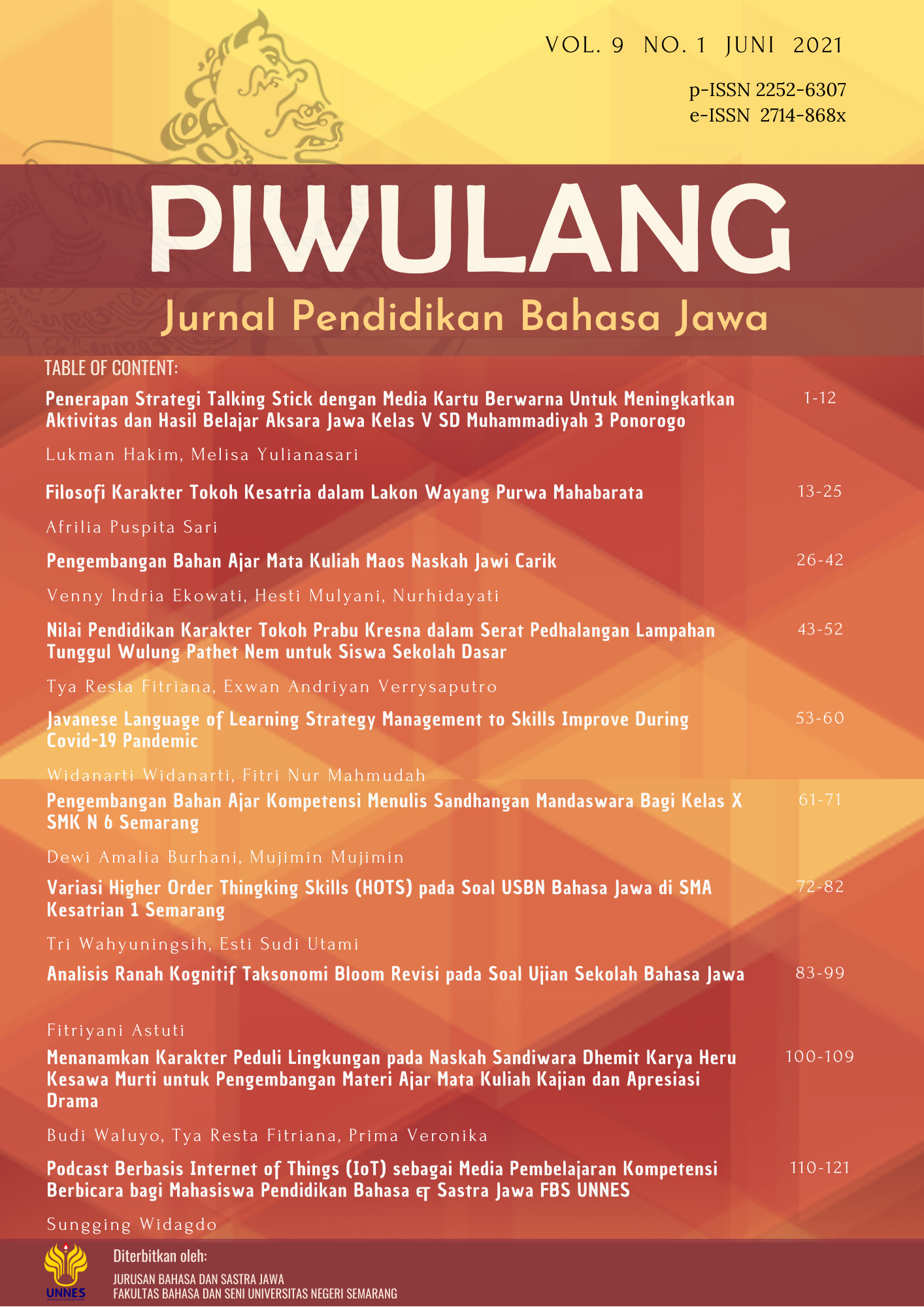Variasi Higher Order Thingking Skills (HOTS) pada Soal USBN Bahasa Jawa di SMA Kesatrian 1 Semarang
##plugins.themes.academic_pro.article.main##
Abstract
The implementation of Higher Order Thinking Skills (HOTS) on Javanese Language National Standard School Exam Questions is needed to improve students' thinking power. HOTS’s question is not a difficult one but a matter of honing students' active abilities to create students who are able to think in a complex and deep way to solve a real problem. The research objectives are: (1) describe the implementation of HOTS about Javanese Language National Standard School Exam Questions in Senior High School 1 Kesatrian Semarang (2) describe the comparison of HOTS about Javanese Language National Standard School Exam Questions between 2017/2018 and 2018/2019 academic year. This study used a qualitative descriptive approach, data were collected using document study techniques. The results showed that the implementation of HOTS on the 2017/2018 and 2018/2019 USBN questions was distributed at the C4 cognitive level, the cognitive processes of "differentiating", "organizing", and "attributing". Cognitive level C5 "checks" cognitive processes, and cognitive level C6 "cognitive processes". In the Java language USBN problem, HOTS implementation in the cognitive process variations is still less varied. At the cognitive level C5 there is no "criticizing" cognitive process, while at the C6 cognitive level there are no cognitive processes of "formulating" and "planning".
##plugins.themes.academic_pro.article.details##
References
Djiwandono, S. (2011). Tes Bahasa Pegangan bagi Pengajar Bahasa. (B. Sarwiji, Ed.) (2nd ed.). Jakarta: PT Indeks.
Hartini, T., Misri, M. A., & Nursuprianah, I. (2018). Pemetaan HOTS Siswa Berdasarkan Standar PISA dan TIMSS untuk Meningkatkan Mutu Pendidikan. Eduma: Mathematics Education Learning and Teaching, 7(1).
Helmawati. (2019). Pembelajaran dan Penilaian Berbasis HOTS. (P. Latifah, Ed.) (1st ed.). Bandung: PT Remaja Rosdakarya.
Kurniasih & Sani. 2016. Revisi Kurikulum 2013 Implementasi Konsep dan Penerapan. Jakarta. Kata Pena.
OECD, 2013. PISA 2015 Draft Science Framework. Diakses dari http://www.oecd.org/pisa/pisaproducts pada 4 Desember 2019 pukul 19.30 WIB.
--------, 2016. Programme for International Student Assesment (PISA) Result from PISA 2015. Diakses dari http://www.oecd.org/pisa/pisaproducts pada 4 Desember 2019 pukul 20.00 WIB.
Peraturaan Menteri Pendidikan Dan Kebudayaan Republik Indonesia Nomor 4 Tahun 2018 Ujian Sekolah Berstandar Nasional (USBN)
Siaran Pers Nomor: 408/sipres/A5.3/XII/2019 Menteri Pendidikn dan Kebudyaan
Srabilor, A. (2014). Profil SMA Kesatrian 1 Semarang. https://srabilor.blogspot.com/2014/10/profil-sma-kesatrian-1-semarang.html. Diakses tanggal 22 Februari 2020.
Sugianto. 2018. “Mengenal Konsep HOTS dalam Pembelajaran Kurikulum 2013†http://www.tozsugianto.com/2018/04/konsep-hots-dalam-pembelajaran-kurikulum-2013.html, diakses tanggal 15 Januari 2020.
Sugiyono. (2015). Metode Penelitian Pendidikan Pendekatan Kuantitatif, Kualitatif, dan R&D (21st ed.). Bandung: Alfabeta.
TIMSS and TIMSS Advanced 2015. 2016. Highlights From TIMSS and TIMSS Advanced 2015. NCES, IES, U.S. Department of Education. Washington
Uno, Hamzah B dan Koni, Satria. 2014. Assesment Pembelajaraan. Jakarta: Bumi Aksara
Widana, I W. 2017. Modul Penyusunan Soal Higher Order Thingking Skill (HOTS). Jakarta: Direktorat Pembinaan SMA, Direktorat Jenderal Pendidikan Dasar dan Menengah Kementerian Pendidikan dan Kebudayaan
